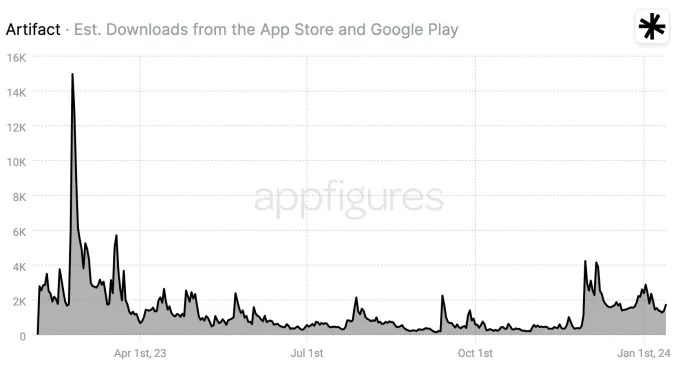Last week, Artifact, a noteworthy news app developed by Instagram’s co-founders, announced its closure due to challenges in achieving critical mass. Despite positive feedback from its core audience and its strategic use of AI for recommendations, news summarization, and clickbait rewriting, along with a sleek and modern design, the app faced unexpected setbacks. New data reveals that Artifact struggled to compete and expand its user base globally, experiencing a significant decline in downloads after the initial launch, failing to resonate with a broader audience.
In a blog post, Kevin Systrom, co-founder of Instagram and Artifact, explained that the decision to shutter the app stemmed from the realization that the market opportunity didn’t justify further investment. Despite appearances of traction, especially within its active community, the startup opted for an early exit, a rare move in the industry but deemed beneficial for all parties involved.
Artifact managed to create a vibrant community with engaging features, such as social interactions around news articles and links. The app fostered discussions, likes, and comments, showcasing signs of an active user base. However, the challenge lay in maintaining sustained interest beyond the initial phase, relying heavily on its dedicated community.
Appfigures data indicates that Artifact garnered approximately 444,000 downloads since its February 2023 launch, with a notable portion occurring around that time. However, by October 2023, the app experienced a stagnation, with only 12,000 new installs. A brief surge in late November and early December wasn’t sufficient to salvage the app, leading to its eventual demise.

Image Credits: Appfigures
Another challenge faced by the app was intense competition. Despite SmartNews, a rival news aggregator, witnessing a decline in downloads and active users amid a CEO shake-up, it still outperformed Artifact. During Artifact’s presence in the market, SmartNews secured 2 million downloads, while Artifact lagged with less than a quarter of that figure.
The evolving landscape of news consumption posed another hurdle. In the era of AI, where search engines and chatbots provide information without the need for clicking links or reading lengthy stories, web publishers are grappling with shifting consumer behavior. This change may reduce the demand for secondary news apps alongside built-in newsreaders like Apple News or Google News on smartphones.
Artifact’s struggle extended to gaining international traction, crucial for sustained success. The U.S. accounted for 44% of all downloads, with no other country exceeding a 4% share. The fame of Artifact’s founders, Kevin Systrom and Mike Krieger (Instagram creators), might not have translated into as much appeal beyond the U.S. tech scene.
The app’s expanding feature set also contributed to its challenges, deviating from its original focus on delivering an AI-powered news reading experience. The addition of features like link and text posts, sharing places, and various AI tools potentially confused users about the app’s core identity—was it a social news reader or a social network?
Artifact’s exploration of AI tools, including generative AI for images and AI summaries in different styles, raised questions about its direction. The app seemed to transform into a testing ground for the latest tech, leaving uncertainty about its planned roadmap.
Originally self-funded by the co-founders, Artifact’s early closure could be attributed to avoiding the challenge of raising funds from investors without guaranteed returns. Despite Artifact’s fate, Systrom hinted at future ventures, expressing personal excitement about continuing to build new things in the tech world, leaving room for speculation on what that might entail.

